1979 Spanish Grand Prix race report
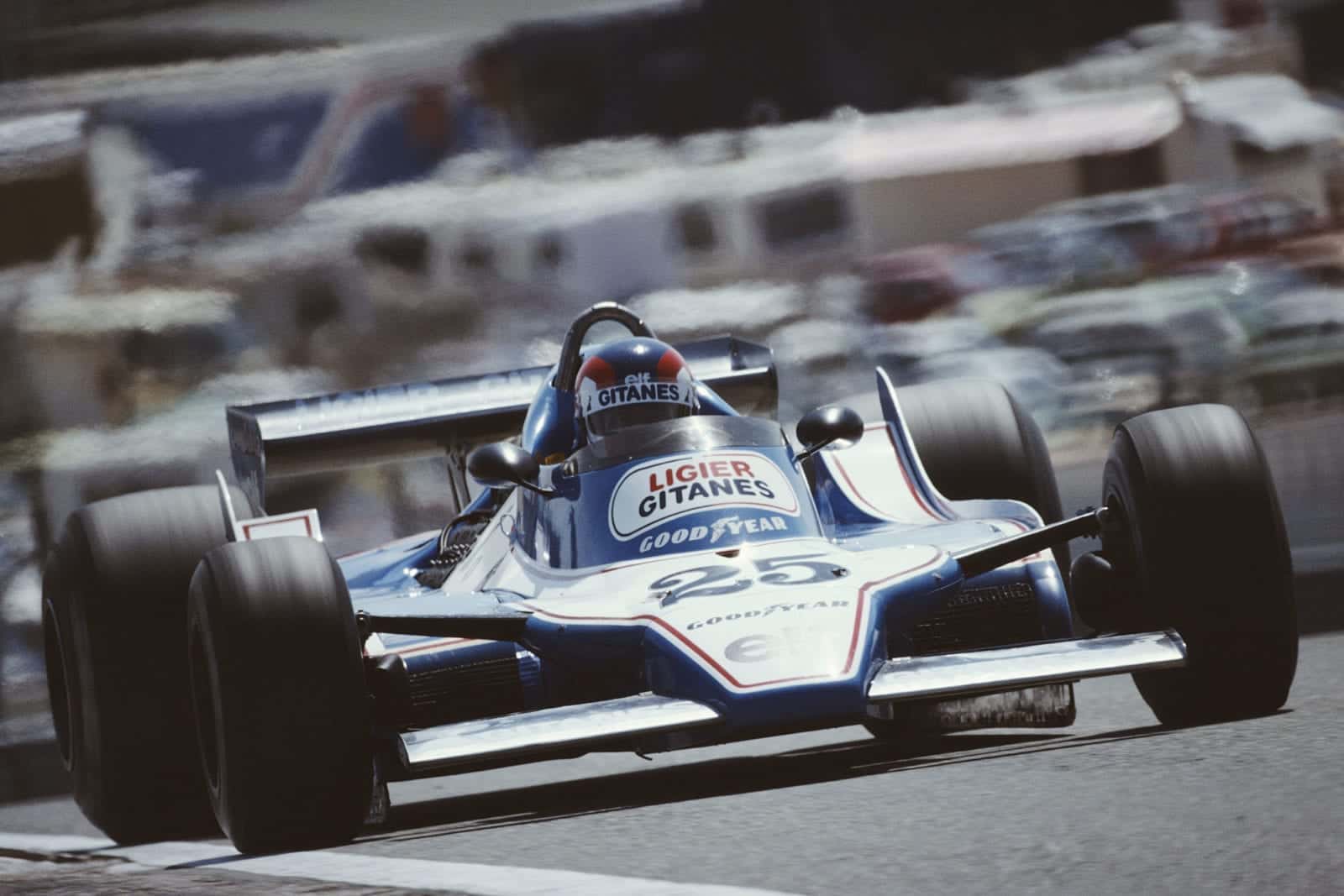
Ligier's Patrick Deapiller claimed a first win of the season at Jarama
Motorsport Images
Not very exciting
Jarama, Madrid, April 29th
The Grand Prix in Spain was the first in Europe for the 1979 season and inevitably it was held on the “mickey-mouse” Jarama Autodrome, as it is the only place in Spain suitable for the elite of the racing world to disport themselves. Such is the state of the art today, thanks to the Constructors’ Association, that the entry list was full and contained brand new designs from Lotus, Renault, Williams and Kauhsen as well as an “interim” new design from McLaren, all of which are described elsewhere.
The new time-table tried out at Long Beach has now been accepted for all races, as nobody found fault with it, so Friday morning saw everyone out for one hour of untimed testing, in readiness for an hour and a half of timed practice in the afternoon. With a strong wind behind them down the straight most cars were pulling a high top-gear ratio and decisions were being taken on whether to use four out of the available five speeds for the rest of the circuit, or all five, or five out of six, or all six. On the wiggly Jarama Autodrome the gearbox gets as overworked as the brakes do at Long Beach or Zolder, and most engineers like to avoid the use of first gear at all cost, and the use of second gear as much as possible, for no drivers are respecters of torque and gear-teeth strength. Normally the exhaust noise of a car passing between the Grandstand and the pits makes a very healthy sound as it reverberates between the two, but with the strong following wind the noise was very soft and gentle, almost as if it was being blown back up the pipes.
Qualifying
The noise should have started at 10 a.m., but it did not start in fact until midday. The official reason given for the delay was that doctors and ambulances had not arrived, but there were other unofficial reasons mentioned and later the FISA called for an official enquiry into the delay (it is discussed in Reflections). While this delay irritated most teams, Lotus and Renault were very happy as neither of them had got their new car ready at 10 a.m., but they had by midday.
When it all got underway Andretti was in the Lotus 80, Reutemann in the Lotus 79 he has been driving all season so far, Pironi and Jarier in their usual Tyrell 009 cars, Lauda and Piquet in their usual V12 Alfa Romeo powered Brabhams, but John Watson was in an entirely revamped McLaren M28, built around the monocoque of the first M28. Tambay was in his usual M28 and Stuck was in the newer of the two ATS cars, Scheckter was in Ferrari 038, Villeneuve in 037, and Fittipaldi was in his F6 Bellamy-designed car. Jabouille had the brand new RS01 car. Lammers and de Angelis were in the pair off Shadows, Hunt was in the latest Wolf, Daly had an old Ensign and Merzario was in his latest car. Depailler and Laffite were in their usual Ligier cars, while Jones and Regazzoni were in brand new Williams FW07 cars, the Australian having the first car built, which was tested in California and the Swiss having the second car, which had yet to turn a wheel. Patrese and Mass had the same Arrows as in Long Beach and Rebaque had his Lotus 79. In the paddock, desperately trying to join in was Willy Kauhsen’s entry for Giancarlo Brancatelli, the WK/004 was being worked on and WK/005 was being cleaned up after a small fire had broken out when it was tow-started.
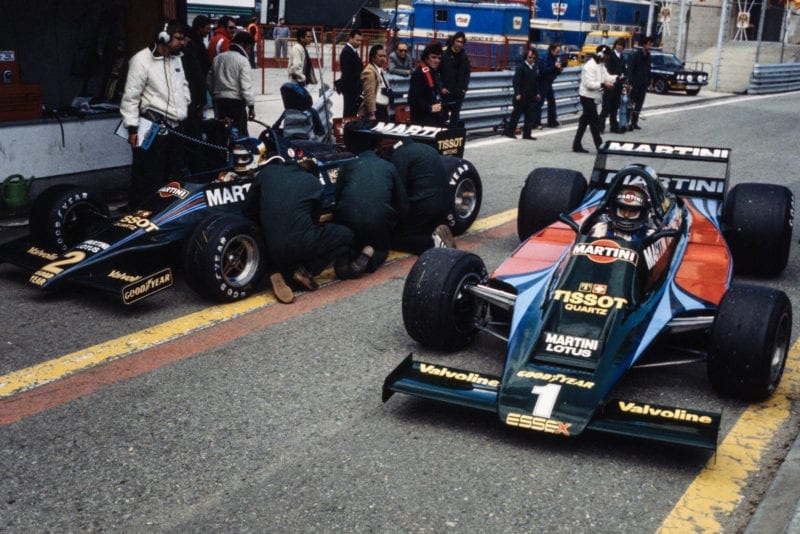
Lotus were debuting the their new ’80’ car
Motorsport Images
Before the hour was up there were various troubles; the new Renault broke its turbo-charger linkage and had to be towed in and Hunt’s Wolf WR8 seemed down on power, so he changed to WR7. The Brabhams were running without nose-fins, and the Williams team were preparing to follow it, while in direct contrast Andretti was running the Lotus 80 with nose-fins and no skirts under the nose cowling. The good cars were clocking over 260 k.p.h. past the pits and the not so good ones were only just over 250 k.p.h.
Due to the two-hour delay in the morning everything ran two hours late for the rest of the day and the timed practice session was from 2.30 p.m. to 4 p.m., but it made little difference to the icy blast, the cold wind being more than the noon-day sun could compete against. Some drivers like Piquet and Mass were getting on with it from the word go, while others were still fiddling about or conserving their limited supply of special Goodyear tyres. Scheckter was braking incredibly late at the end of the main straight and Velleneuve going hard, overtaking cars without hesitation going into corners, even nipping by World Champion Andretti without so much as an “excuse me”. Hunt was still in WR7 and Jabouille was back on the track with the turbo-charger repaired on the RS10 Renault. Piquet’s V12 Alfa Romeo engine blew up and practice was stopped while the stricken Brabham was removed and the mess cleared up. Then everyone was off again and this time the Kauhsen team managed to get their car going and Brancatelli headed out into the hurly-burly of professional driving. The Williams team were experimenting running minus the nose-fins and then tried without the engine cover as well. Fittipaldi stuck valiantly to his new car, even though it still did not handle to his liking, but as the session wore on he went slower and slower. Watson was not much better with the revamped McLaren M28 and the way the centre-mounted rear aerofoil wobbled about caused some concern among those watching out on the circuit. The two Ferrari drivers on their Michelin tyres were really setting a fast pace, and Villeneuve was embarrassing his South African team leader. Times were so far below those recorded last year that one was almost tempted to doubt the official time-keepers, but individual time-keepers in the teams agreed, so we were resigned to accepting a remarkable advance in just twelve months. From a fastest practice time last year, of 1 min. 16.39 sec. by Andretti with a Lotus 79, it was already down to 1 min. 14.87sec. by Villeneuve with the T4 Ferrari. While he was in a class of his own at under 1 min. 15 sec., Scheckter, Laffite, Depailler, Reutemann, Andretti, Arnoux and Pironi were all under last year’s fastest time. There was a tidy appearance about the final order after this first practice that was to continue throughout the meeting. Two Ferraris, then two Ligiers followed by the Lotus pair. While some drivers like Scheckter, Jarier, Patrese, and Rebaque did 40 laps. Poor Merzario only managed five and Brancatelli seven, as minor troubles kept bringing them back to the pits before they could complete a full flying lap. Apart from these two Daly was the first non-qualifier on this first day, only 24 of the 27 cars being allowed in the race.
On Saturday morning conditions were unchanged, except that the “test” hour got under way promptly at 10 a.m. The Renault team were still in trouble as Arnoux went off the track with a broken rear wishbone and the turbo-charger seized on the new car, but in spite of all the problems both cars were well up on the grid. The Shadow team were also having troubles, but were not so well placed; Lammers’ car had its final drive unit apart in the pit lane, and de Angelis felt much happier in the spare car, though he just wasn’t fast enough to make his presence felt. Hunt was trying both Wolf cars, set up differently as regards suspension and handling, and found he preferred WR7. Fittipaldi abandoned his new car once more and returned to his “old faithful” F5A/1, and so to the afternoon timed session, with some drivers having “special” tyres and some not, some drivers having enough special tyres and some not, most drivers on Goodyear tyres and four on Michelin. There was a certain amount of bickering about “unfair” because the Ferrari drivers had an almost unlimited supply of special tyres and the favoured Goodyear runners only had two or three sets; it is just this sort of reason that encouraged Enzo Ferrari into collaborating with Michelin to get the tyres he wanted, instead of standing in the Goodyear queue with Lotus, Brabham, McLaren, Tyrrell and the rest.
The pace warmed up considerably in the afternoon and it was the Ligier team that were setting the standards; whether Gerard Ducourouge and his engineers have some secret “tweak” or not we’ll never know, for if they have you can rest assured they are not going to tell anyone. Some say they have some special tricks with aerodynamics, others say it is some tricks with tyres. There is no doubt the cars handle well and are nice to drive, for both Laffite and Depailler are very happy with them. On the advice of Scheckter the Ferrari team had altered their ratios in the gearbox, but Villeneuve wasn’t convinced they had done the right thing. Chapman and Andretti were quietly getting on with the fine tuning of the Lotus 80, and making good progress, but Reutemann was delayed while a split water radiator on his Lotus 79 was changed. Lauda had used up all his special tyres and packed it in quite early, while Piquet was very close behind his team-leader’s best lap time, back in his original car with a fresh engine installed. Both Ligier drivers were under the magic 1 min. 15 sec. mark, as was Villeneuve, when suddenly an excited buzz came from the Ligier pit. Laffite had one 1 min. 14.50 sec. and was firmly established on pole position on the grid, with Depailler alongside him, but the little French-Canadian was right behind them, these three being in a class of their own. Scheckter had been trying the spare Ferrari, 039, and felt happier with it though he was not as fast as he had been with 038. For quite a while he was in fourth place alongside Villeneuve on the second row of the grid, but towards the end of the hour-and-a-half Chapman and Andretti began to get the Lotus 80 somewhere near right and the World Champion did a 1 min 15.07 sec. which ousted Scheckter down into the third row of the start alongside Lauda, with Piquet and Reutemann behind them. The Tyrrells and the Renaults came next and then the two Williams cars showing good promise for a new design, but the new McLaren was little better than the old one. Rebaque and Lammers were on the last row of the grid and Daly (Ensign), Merzario and Brancatelli failed to qualify.
Race
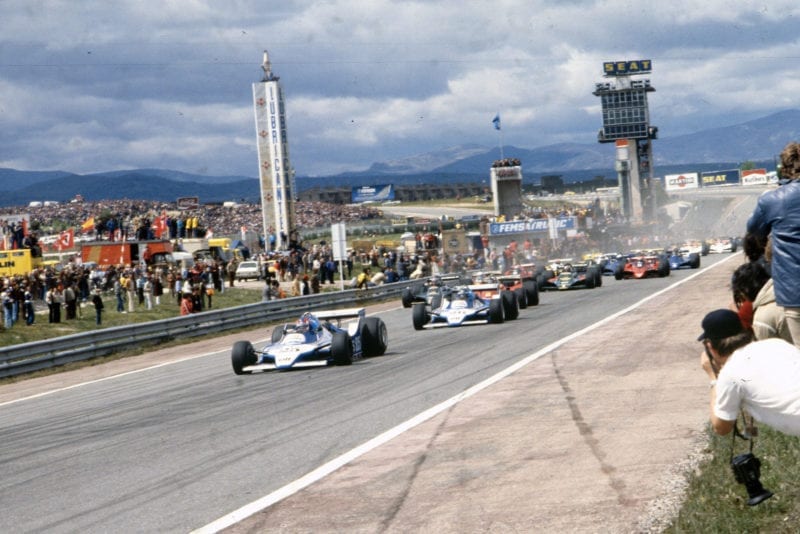
Depailler takes the lead into Turn One
Motorsport Images
Sunday saw more clouds in the sky and the icy wind dropped a bit, though it was by no means warm and a very large crowd poured out to the Autodrome, in spite of the high admission charges being asked. A thirty-minute warm-up period took place at midday, and Villeneuve was the first away. Fittipaldi was planning to race his old car, Hunt was in WR7, Scheckter in the spare Ferrari and de Angelis in the spare Shadow. All twenty-four cars and drivers were fit and ready for the start of the 75-lap race, which was due to start at 4 p.m., once the King of Spain had arrived by Royal helicopter and the drivers had been officially presented to him by J. Stewart Esq. From the green light, apart from the initial rush off the grid, the two Ligiers had it all their own way, they simply disappeared into the distance with Depailler leading Laffite. There were not team-orders so they sort-of raced against each other and Laffite pushed as hard as was reasonable on a team-mate, but not as hard as he would have done on a rival team member. On lap 3 Depailler went round in 1 min. 18.39 sec. and these were their fastest laps in the race. Meanwhile all sorts of things were going on behind them; Reutemann (who had made a superb start) led Villeneuve, Scheckter, Andretti, Lauda, Pironi and Piquet, but on lap 4 the young Ferrari driver tried to get the better of Reutemann under braking for the hairpin at the end of the straight, got in a muddle and spun, baulking Jarier and Pironi very badly as he did so. The Tyrrell went on but the Renault had a spectacular “flame-out” in the megaphone exhaust and by the time Jabouille got the engine back on the boil everyone had gone. This mistake dropped Villeneuve down to eighth place behind Piquet, and on the next lap he spun again at the same place and fell to thirteenth position behind the two Williams cars. Down the field an unhappy Watson was struggling along in sixteenth place, only just managing to stay ahead of Tambay, and Hunt was at the back having got boxed in on the first lap.
A bare half-a-dozen laps saw the scene settle down into four pairs and the miscellaneous rest. First there were the two blue and white Ligiers of Depailler and Laffite in full command, then came Reutemann and Scheckter, Andretti and Lauda, and then Piquet and Jarier. The older Renault of Arnoux was leading the rest who were Pironi, Regazzoni, Villeneuve, Patrese, Mass, Watson, Tambay, Stuck, Lammers, Fittipaldi, Rebaque and Hunt. A long way back came de Angelis, having been off at the main hairpin, and Jabouille, while Jones was in the pits having a deflated tyre changed on his new Williams. Just as everything seemed settled two of the front runners disappeared. At the end of the straight Piquet shut off and braked as usual, and when he came to open up the throttle pedal was jammed! Part of the fuel-injection unit had broken and jammed the mechanism. This was as he was starting lap 16, and almost at the same time, half-way round the circuit, Laffite had missed a gear-change and blown up his Cosworth engine, leaving Depailler to breathe a sigh of relief and continue on his own well out of reach of any opposition. Scheckter felt he might have done something about the Ligiers had he been able to get by Reutemann, but he was having his work cut out to do anything about the Lotus 79.
Although to the casual spectator it looked as if everyone had given up trying and was merely cruising round, it was far from so, for apart from Depailler, who was cruising, the rest were driving harder and harder every lap, though not actually getting anywhere. The new Renault retired with turbo-charger trouble, Watson coasted to rest out on the circuit with a dead engine, which was merciful relief, and Hunt retired with overheated brakes. The only changes had been in mid-field where Arnoux had dropped back and Regazzoni had eventually got by Pironi, but then the engine went sick in the Williams and that was the end of the race for the Swiss driver. Although he was at the back of the field Alan Jones was showing the worth of the new Williams FW07 by pressing on hard, and lapping faster than anyone else.
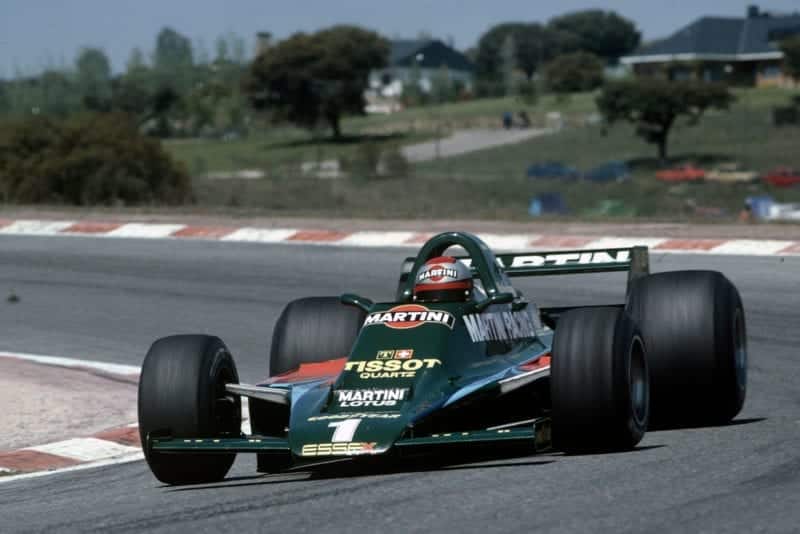
Mario Andretti secured the final podium place for Lotus
Motorsport Images
For a long time Hector Rebaque was hanging on to the tail of Fittipaldi’s car, and no doubt learning quite a lot, and even when the leaders began to lap them he still stayed with the Brazilian. While lapping Tambay, Andretti had collided with the McLaren and broken the right-front nose-fin off the Lotus 80, but some clever juggling with the adjustable roll bars corrected the instability, though while finding the settings Lauda overtook the Lotus. This had happened on lap 43 and Jones had run over the broken fin and collected another puncture, which gave him another pit stop. He was soon back in the race driving harder than ever and on lap 47 he made the fastest lap in the race, up to then, in 1 min. 18.00 sec., in spite of a troublesome gear-change. The linkage had played up before the start, and he was having to be a bit brutal with his gear-changes. Eventually the new Hewland gearbox cried “enough” and after 55 laps gave up.
Encouraged by passing the Lotus 80 Lauda now worked away at Scheckter’s Ferrari, and eventually got by on lap 60, which put him into third place, behind the confident, cruising Depailler, and Reutemann’s Lotus 79. The glory only lasted for three laps, for the Alfa Romeo V12 engine was losing water and when the temperature soared sky-high that was the end of a gallant run. Rebaque’s dice with Fittipaldi ended when the chocolate-brown Lotus 79 burst its engine, spewing oil all over the back and in the final ten laps Andretti got the Lotus 80 well wound up and caught and passed Scheckter’s Ferrari on lap 67, to drop neatly in behind Reutemann’s Lotus 79.
There was no disputing Patrick Depailler’s victory, he led from start to finish, without straining himself and the Ligier JS11 was faultless. The solid and consistent Reutemann did a good job in finishing second and Team Lotus were not too unhappy with the first race of the Lotus 80. Scheckter was not very satisfied with his fourth place tending to talk about worn-out Michelins, but he made his fastest lap on lap 73, bad Michelins or not! Jarier was fifth and Pironi was sixth, which pleased Ken Tyrrell, and in seventh place, and catching up fast, was Villeneuve. On lap 58 he had gone into the pits and in a lightning stop the Ferrari mechanics had changed all the wheels and tyres, fitting a set of short-life softer tyres, and Villeneuve had set off with the sole object of creating a new lap record. This he did on lap 72 in 1 min. 16.44 sec., which was the middle one in a run of five laps in the 1 min 16 sec bracket. Up to that point Jones had held the lap record with his 1 min. 18.00 sec done on normal racing tyres.
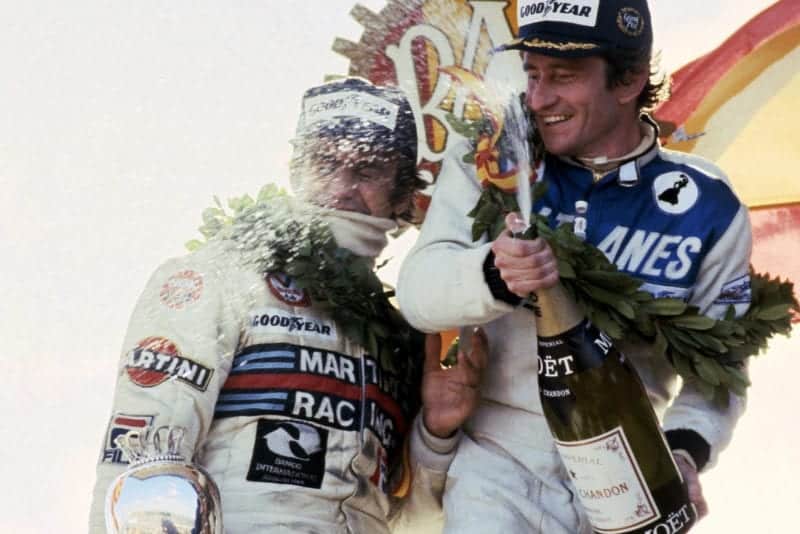
Depailler celebrates on the podium
Motorsport Images
The last car not to be lapped was Arrows of Jochen Mass, the German having driven a good hard race, and beating his young Italian team-mate. Arnoux, Patrese, Fittipaldi, Lammers, Tambay and Stuck all finished one or more laps down, the last three having lost time with pit stops for various problems. – D.S.J.
